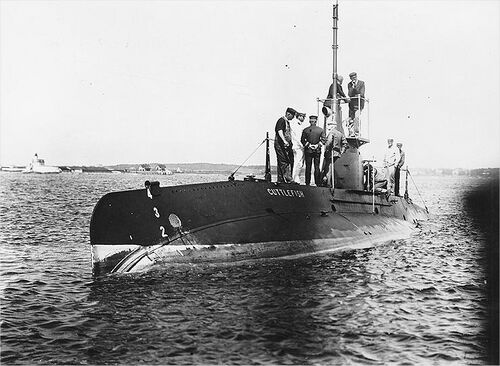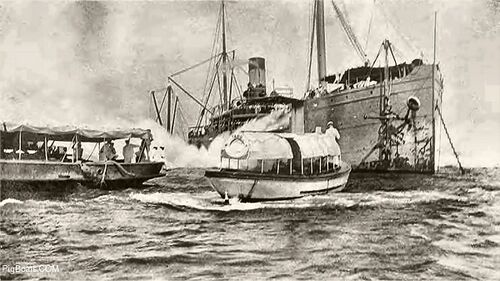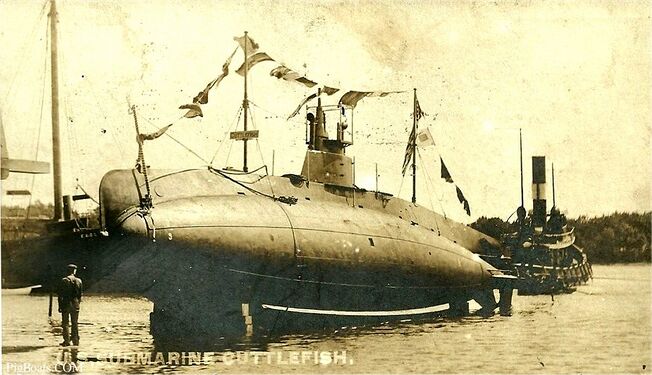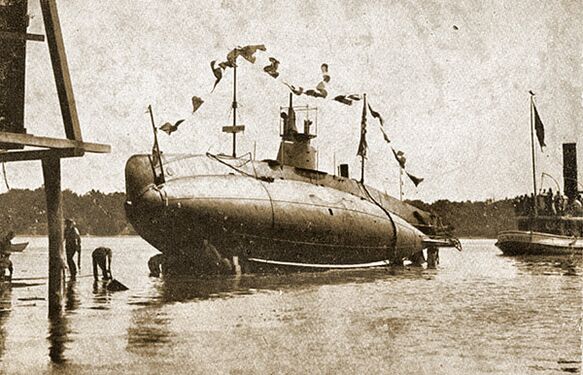B-2: Difference between revisions
Pbcjohnston (talk | contribs) mNo edit summary |
Pbcjohnston (talk | contribs) Deleted redundant torp room photo |
||
| (3 intermediate revisions by 2 users not shown) | |||
| Line 1: | Line 1: | ||
[[File:B- | [[File:New Header B-class.jpg]] | ||
<br> | <br> | ||
<div style="text-align: justify;"><span style="color:#00008B"> | <div style="text-align: justify;"><span style="color:#00008B"> | ||
<gallery mode="packed" widths=" | <gallery mode="packed" widths="350px" heights="250px"> | ||
File:B-2 launch.jpg|<small>Photo in the private collection of Rid Hedman.</small> | File:B-2 launch.jpg|<small>Photo in the private collection of Rid Hedman.</small> | ||
File:Cuttlefish B-2 hung up on ways.jpg|<small>Photo NH 44579 courtesy of the NHHC.</small> | File:Cuttlefish B-2 hung up on ways.jpg|<small>Photo NH 44579 courtesy of the NHHC.</small> | ||
| Line 40: | Line 40: | ||
The vessel in the background is unidentifiable. | The vessel in the background is unidentifiable. | ||
<small>Photo in the private collection of | <small>Photo in the private collection of Ric Hedman.</small> | ||
[[File:Red bar sub.jpg]] | [[File:Red bar sub.jpg]] | ||
Latest revision as of 03:09, 14 March 2025
-
Photo in the private collection of Rid Hedman.
-
Photo NH 44579 courtesy of the NHHC.
These two photos shows Cuttlefish on September 1, 1906 on her launch day, and it reveals a highly unusual and embarrassing event that befell the boat. Cuttlefish, left, is in the middle of the launch process of sliding down the ways into the Weymouth Fore River, but she has hung up on the ways and her slide has stopped just as her hull touched the water. The characteristic wake of the boat and cradle sliding into the water is absent, indicating that she is stopped. A portion of her launch cradle has apparently caught on the track below the water. The shipbuilder got lucky in that the boat could have easily fallen off the cradle and taken damage when it came to a stop.
In the photo to the right workers can be seen wading in ankle deep water on the track in front of the boat, trying to correct the problem, something they would not have done if the boat was in motion. A tug is standing by to finish the launch process, intending to pull the boat the rest of the way into the river. That was accomplished a short time later and Cuttlefish was floated over to the fitting out dock.

Cuttlefish on her builder's trials near Quincy, MA., 1907. There are several officers and civilians on her deck. The civilians would be from the Fore River company that built her and they would be operating the boat for the Navy observers, demonstrating that she could meet her specifications. The vertical numbers on her bow are draft marks, with the "2" indicating 12 feet to the keel.
Photo in the private collection of Rid Hedman.

Cuttlefish moored at an east coast port, possibly the Boston or Brooklyn Navy Yards, approximately 1907-1908. Much like the A-class, it was normal to see these boats at rest with a down angle by the stern.
Photo in the private collection of Rid Hedman.

Here is a partial crew photo of the USS Cuttlefish. The photo is dated between 1907 and 1911 but based on the paint job and the markings on the bow mast we would estimate this is closer to the 1907 commissioning than the later date. See photo above taken on builder's trials.
Two Chief Petty Officers are at the left. One a "Right Arm Rate", probably a Gunner's Mate. Further makings on his right sleeve are most likely a Torpedoman Specialty Mark, (lower), and above that an Ordinance Specialty Mark. The rate of Torpedoman had not been created at the time this photo was taken. The Torpedoman rate was created in 1921 as a Right Arm Rate. All ratings were moved to the left arm on April 2, 1949.
The other Chief is a "Left Arm Rate" most likely something like a Motor Machinist Mate or Electrician's Mate, who worked with the engines or the batteries. Most crew at this time were either Gunner's Mates, Machinist Mates or Electrician's Mates.
The other men are a mixture of rates for the various operations that make the submarine work. There are probably about four men missing from the photo, one being the Commanding Officer. A normal crew compliment was about 10 men.
On deck is a short "mast" with makings showing how far the submarine was under water while diving or surfacing. Directly behind and above the second man from the right is the submarine's periscope and shears that stabilize the periscope under water.
The vessel in the background is unidentifiable.
Photo in the private collection of Ric Hedman.
USS Cuttlefish (Submarine No. 11) crew muster for April 15, 1910. All men listed below are enlisted, rank and rate unknown. Data is incomplete due to lost records.
| Johnson, Michael A. - age 28 - Born: Rhode Island |
| Witcomb, Harris A. - age 29 - Born: New Hampshire |
| Kirstof, John - age 23 - Born: Missouri |
| Pearson, Karl - age 33 - Born: Sweden |
| Meeks, John R. - age 27 - Born: Ohio |
| Hayes, Spencer W. - age 23 - Born: Pennsylvania |
| Sarre, John V. - age 26 - Born: Canada |
| Morris, Edward E. - age 32 - Born: Connecticut |
| Stone, Leland - age 28 - Born: Maine |
| Kelly, Dan - age 28 - Born: Massachusetts |
| Sohn, Robert L. - age 26 - Born: Tennessee |
Thank you to Linda Talbott of the US GenWeb Census Project® for providing this information.

This photo is of the B-2 hitting the water in Manila Bay on May 12, 1913. She was being launched from the deck of the USS Ajax (Collier No. 14) which had carried the B-2 and the B-3 to Manila from Norfolk, Virginia.
The vessel sailed from Norfolk on Thursday, March 27 1913 to clear skies but had to weather a gale in Lynnhaven Bay, Virginia a short time later. From there they crossed the Atlantic and had a scheduled port of call in Algiers before passing through the Mediterranean Sea and the Suez Canal. The ship with submarines arrived in Manila Bay on Wednesday, April 30, 1913. It took twelve days to ready the ship and submarines for launching.
Since there were no large dockside cranes like in Norfolk, in Manila the launching necessitated that the railings of the Ajax be cut away and the building of sloping cradles of 15 to 20 feet in length under the submarines. It was decided in order to maintain the equilibrium of the Ajax that both submarines would be launched at the same time. So, in looking at this photo you have to imagine a similar scene being enacted on the port side of the ship as the B-3 also hits the water.
The event drew a large spectator crowd, and ships and local small craft were present in large numbers. Both vessels in this photo seem to be carrying a large number of Naval personnel to watch the unusual event.
Once the submarines were launched the Ajax carried out her other duties as soon as the needed restoration to the decks and railings had been performed. Besides the cargo of submarines on deck, her holds were full of coal and she commenced coaling ships of the Asiatic Fleet. She had also changed home port and Manila became her new home.
U.S. Navy photo provided by Senior Chief Don.
Page created by:
Ric Hedman & David Johnston
1999 - 2023 - PigBoats.COM©
Mountlake Terrace, WA, Norfolk, VA
webmaster at pigboats dot com


